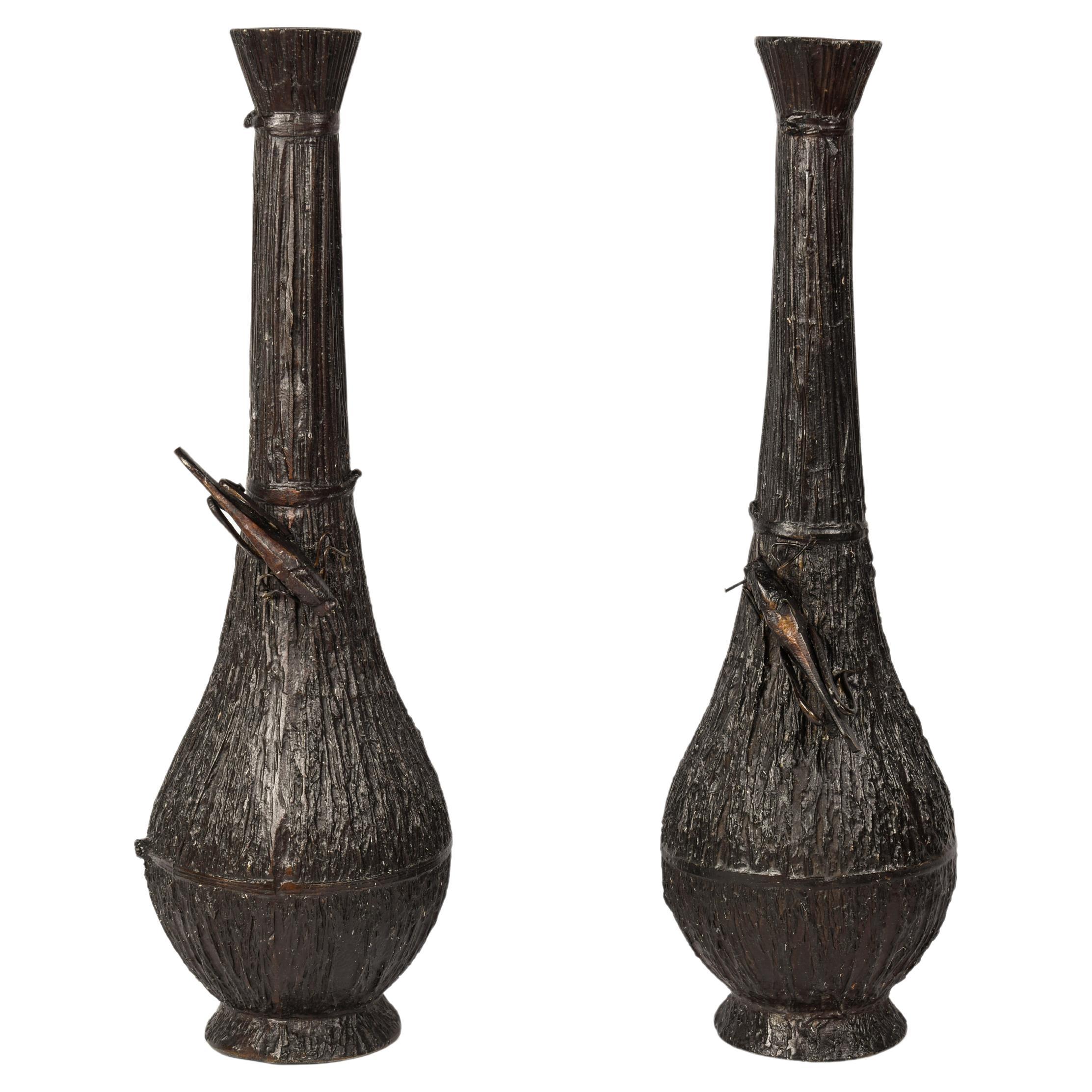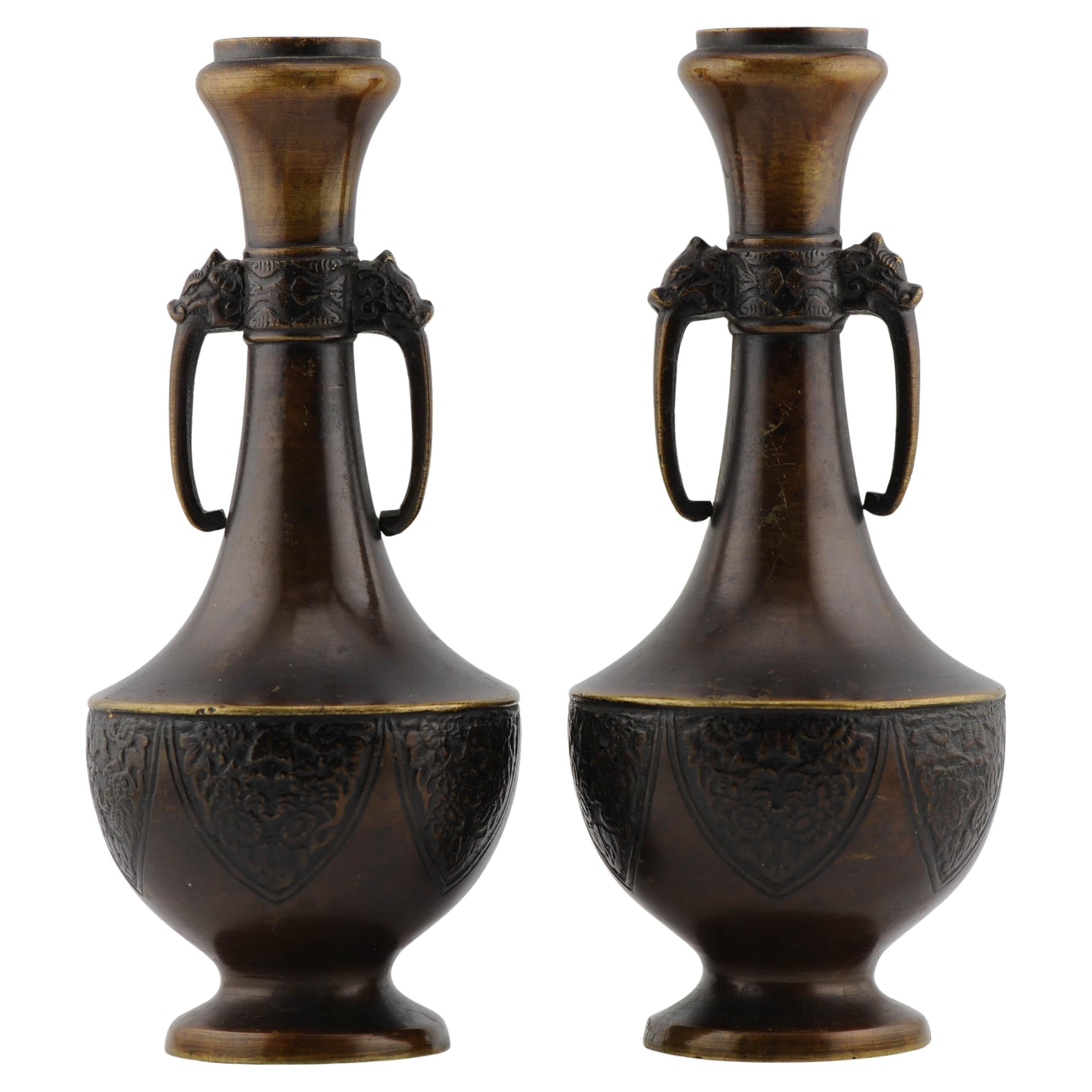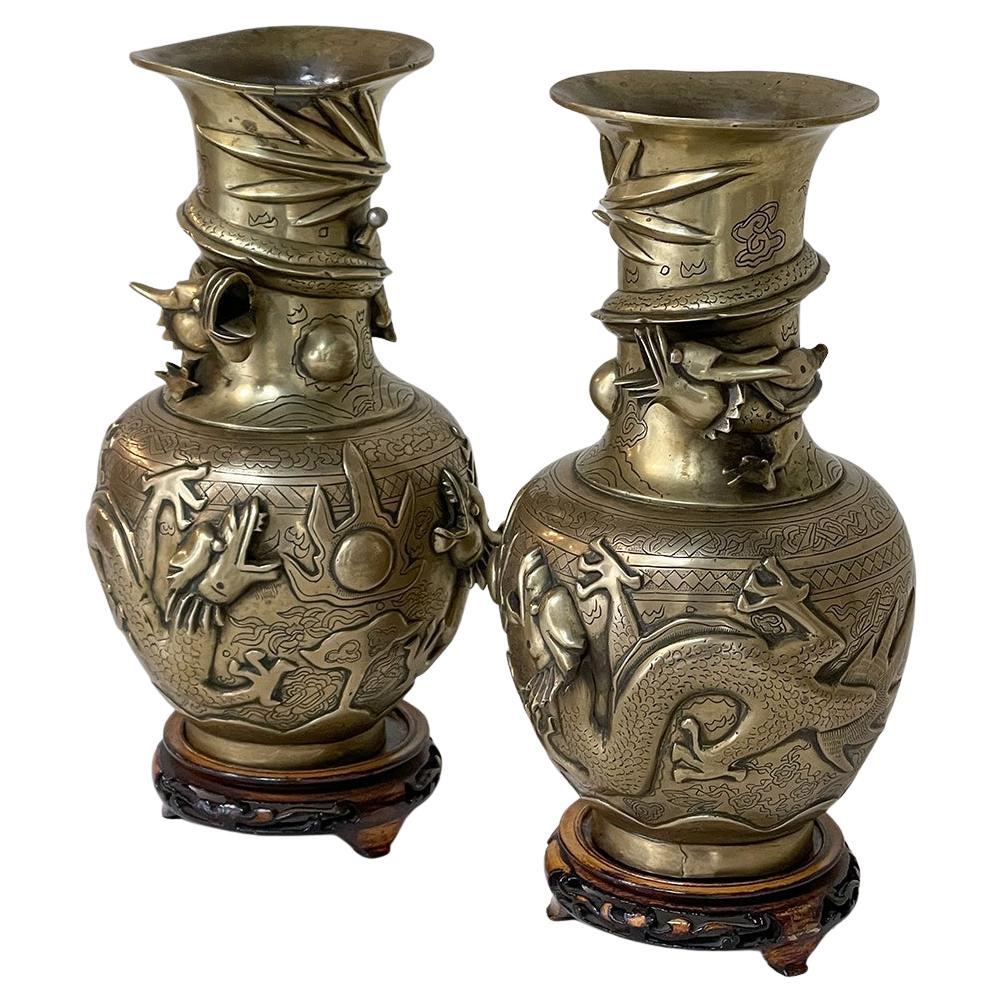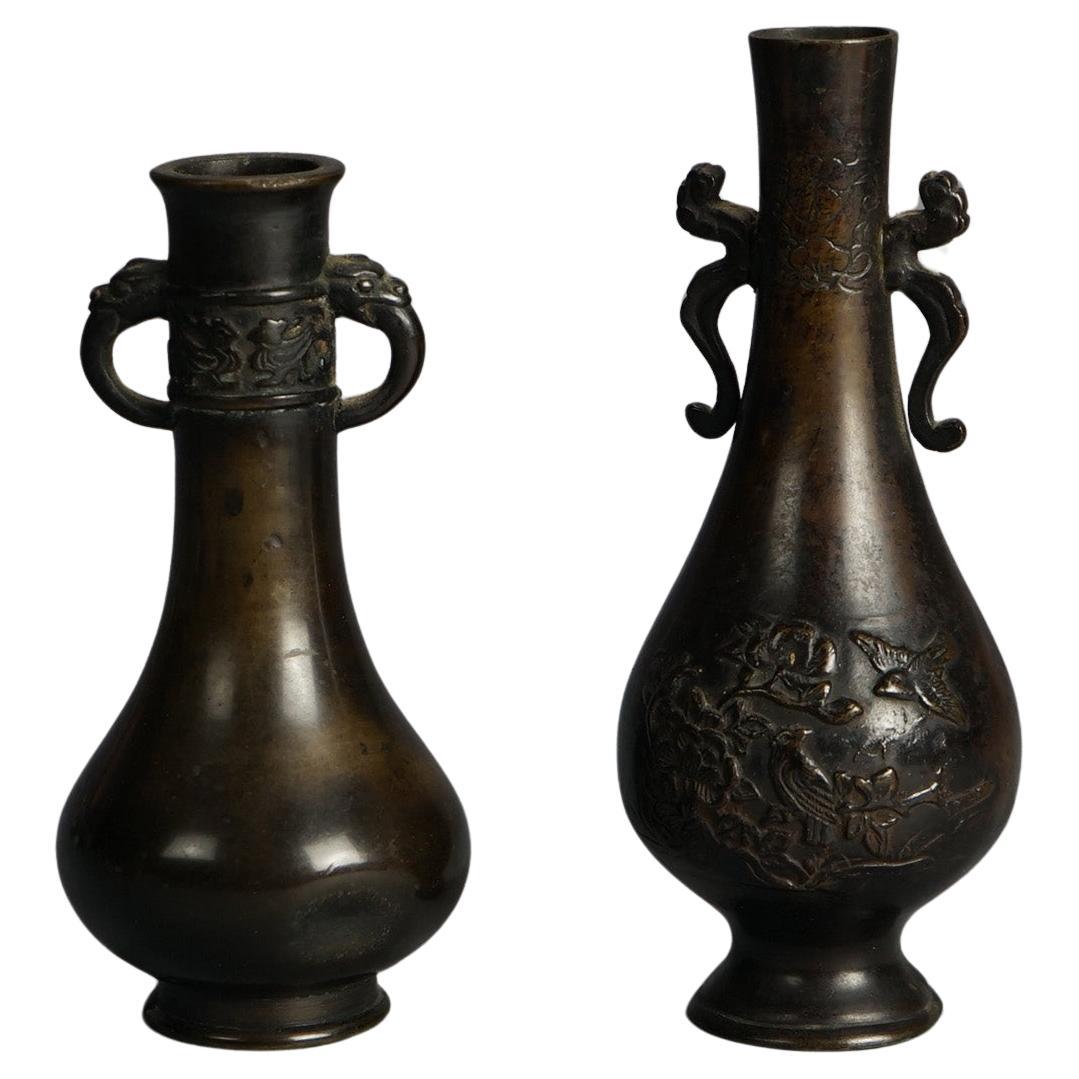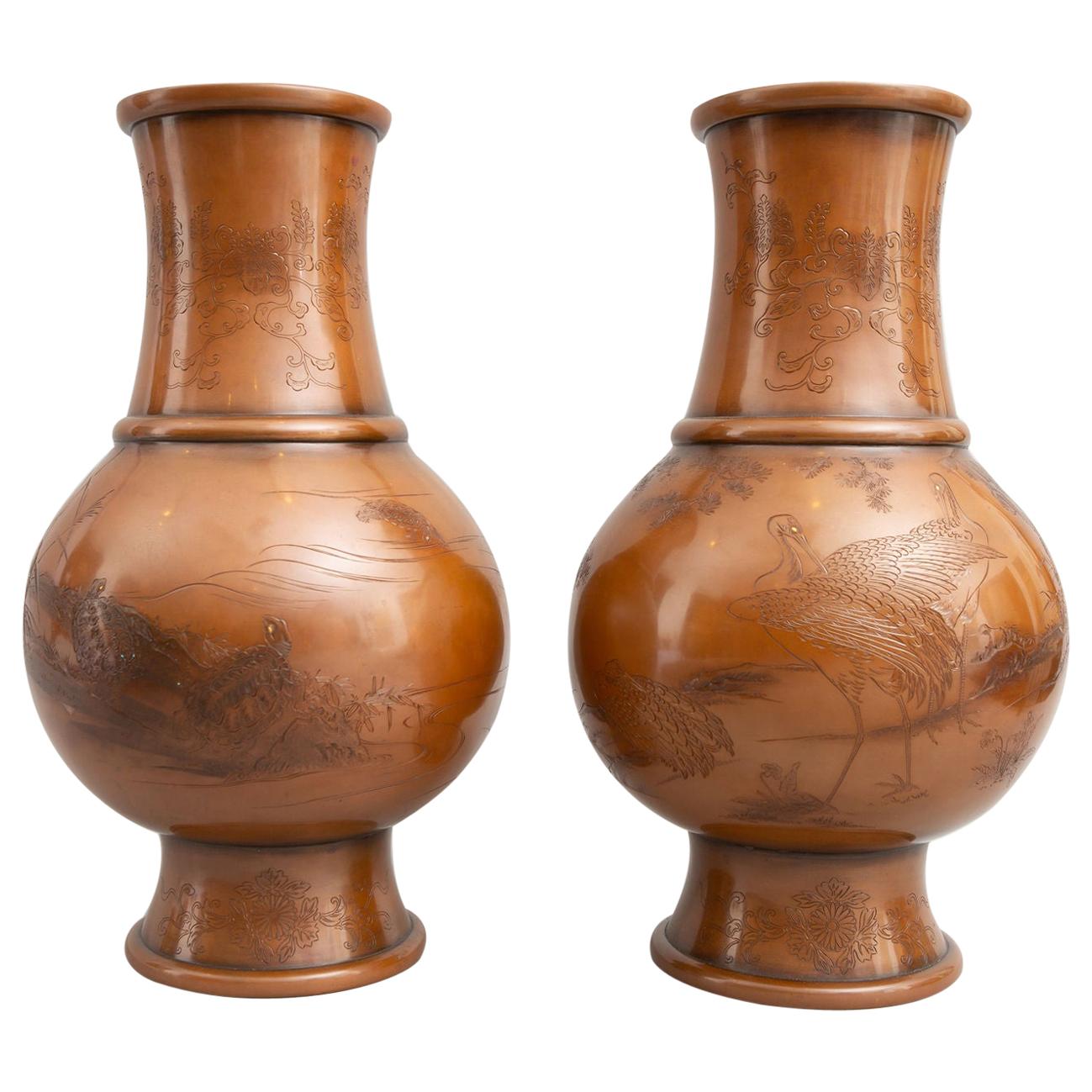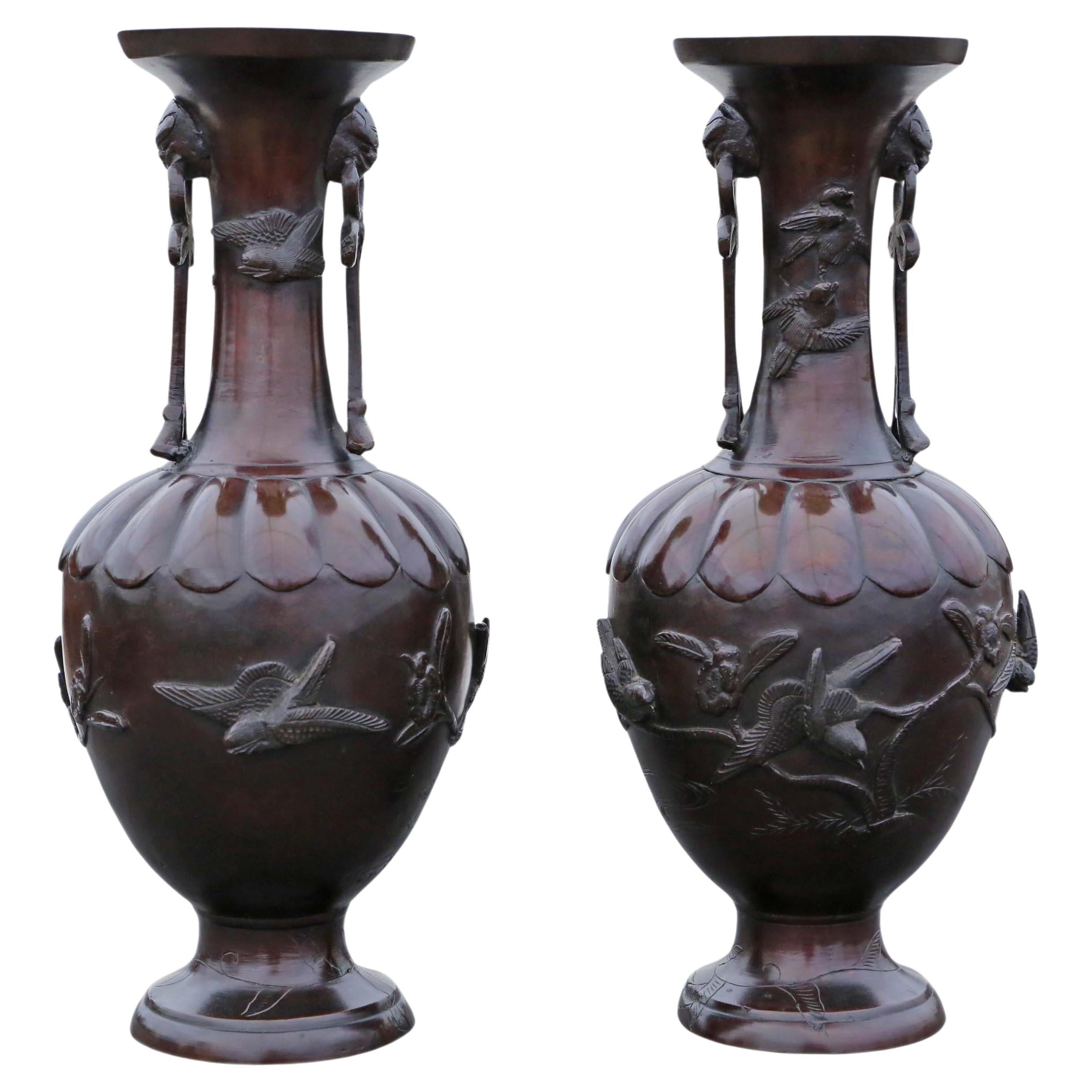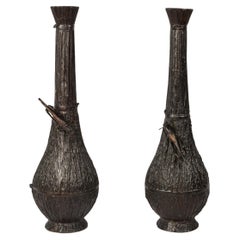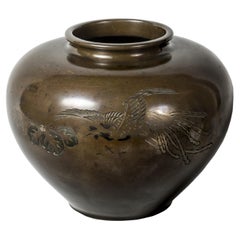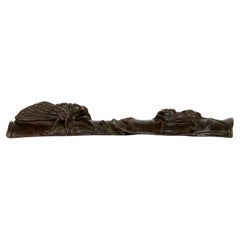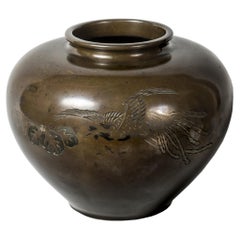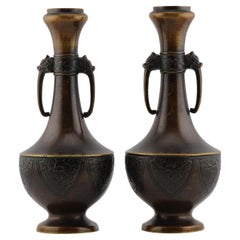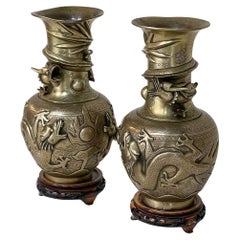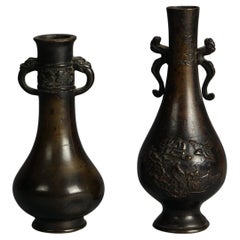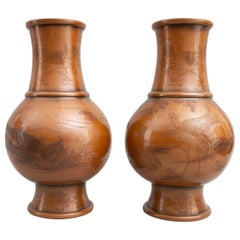Items Similar to Pair of japanese bronze vase imitating hay and decorated with a grass hopper
Want more images or videos?
Request additional images or videos from the seller
1 of 9
Pair of japanese bronze vase imitating hay and decorated with a grass hopper
$4,792.57per set
£3,567.10per set
€4,000per set
CA$6,564.63per set
A$7,301.30per set
CHF 3,812.51per set
MX$88,849.06per set
NOK 48,691.60per set
SEK 45,664.13per set
DKK 30,450.60per set
Shipping
Retrieving quote...The 1stDibs Promise:
Authenticity Guarantee,
Money-Back Guarantee,
24-Hour Cancellation
About the Item
Detailed pair of vases in bronze of baluster form, textured to represent straws of hay, bound together by three knots that divide each vase in three, just under le second ring, a well detailed grasshopper is detached from the rest of the composition.
Insects (mushi) occupy an important place in Japanese culture. Hunting for insects is a popular pastime, especially among children. Using plastic nets and cages, they catch cicadas and beetles to observe them.
Between 1830 and 1832, Hokusai composed an untitled series of ten large horizontal prints to distinguish it from the smaller one, known as the Small Flowers. The grasshopper is the main subject of one of the prints in this series, Iris and grasshopper: Hokusai represents, with finesse and precision, a sheaf of iris, all imprint of vigor and fragility, including most of the orange flowers, variegated with blue and purple, are mostly already open. In the center, on the tallest and most rigid sheet, but also the most damaged, a large grasshopper is represented, the same color as the foliage it is busy devouring.
Japan – Meiji period (1868 - 1912 )
Height :35.5 cm or 13.8 in - Diameter (bulb) :12 cm or 4.15 in
- Dimensions:Height: 13.98 in (35.5 cm)Diameter: 4.73 in (12 cm)
- Sold As:Set of 2
- Style:Meiji (Of the Period)
- Materials and Techniques:
- Place of Origin:
- Period:
- Date of Manufacture:1868-1912
- Condition:Wear consistent with age and use.
- Seller Location:PARIS, FR
- Reference Number:Seller: 2020 - 7601stDibs: LU8311242724042
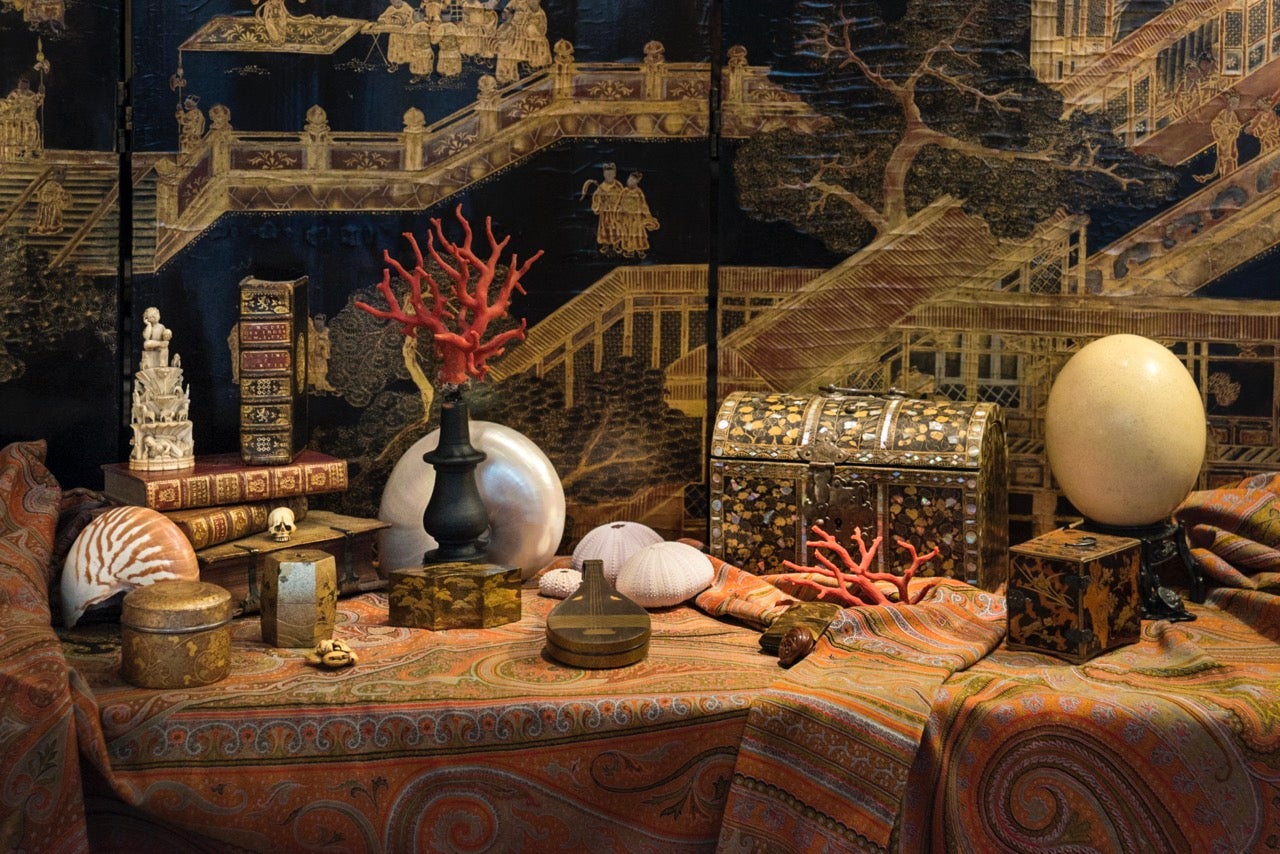
About the Seller
No Reviews Yet
Vetted Professional Seller
Every seller passes strict standards for authenticity and reliability
Established in 2013
1stDibs seller since 2023
Typical response time: Several days
- ShippingRetrieving quote...Shipping from: PARIS, France
- Return Policy
Authenticity Guarantee
In the unlikely event there’s an issue with an item’s authenticity, contact us within 1 year for a full refund. DetailsMoney-Back Guarantee
If your item is not as described, is damaged in transit, or does not arrive, contact us within 7 days for a full refund. Details24-Hour Cancellation
You have a 24-hour grace period in which to reconsider your purchase, with no questions asked.Vetted Professional Sellers
Our world-class sellers must adhere to strict standards for service and quality, maintaining the integrity of our listings.Price-Match Guarantee
If you find that a seller listed the same item for a lower price elsewhere, we’ll match it.Trusted Global Delivery
Our best-in-class carrier network provides specialized shipping options worldwide, including custom delivery.More From This Seller
View AllPair of Japanese Bronze Grasshopper Vases
Located in PARIS, FR
Insects (mushi) occupy an important place in Japanese culture. Hunting for insects is a popular pastime, especially among children. Using plastic nets and cages, they catch cicadas and beetles to observe them.
Between 1830 and 1832, Hokusai composed an untitled series of ten large horizontal prints...
Category
Antique Late 19th Century Japanese Metalwork
Materials
Bronze
$5,990 / set
Japanese Bronze Vase decorated with a Phoenix and paulownia leaves
Located in PARIS, FR
Patinated bronze vase decorated with a flying phenix and paulownia leaves. The phoenix has imperial and solar symbolism. This bird of good omen also embodies virtues from the teaching of Confucius (such as goodness, righteousness, and wisdom). Paulownia (kiri) is considered as a symbol of nobility, honor and longevity. Since the Edo era, there has been a tradition that paulownia is planted at the birth of a daughter to be used later as a material for making items that will be part of her dowry. Its wood is ideal for chests and kimono boxes...
Category
20th Century Japanese Showa Metalwork
Materials
Bronze
Bronze sculpture of two cicadas on a bamboo, used by calligraphs to hold paper
Located in PARIS, FR
Two cicadas in bronze facing each other on a bamboo segment
One is an adult while the other is at the nymph phase. Three foundry stamps, one underneath and one alongside each insect...
Category
Antique Late 19th Century Japanese Meiji Metalwork
Materials
Bronze
Japanese Bronze Vase
Located in PARIS, FR
Patinated bronze vase decorated with a flying phenix and paulownia leaves.
It comes with its tomobako marked with the date Shôwa 5 (1930).
Japan, Shôwa period (1926-1989), 1930
...
Category
Vintage 1930s Japanese Vases
Materials
Bronze
$4,193
Pair of Japanese Abumi Stirrups
Located in PARIS, FR
Pair of stamped brass stirrups decorated with Hashizuka, Ito and Manabe Mons.
Japan - Edo (1615-1868), 18th century.
Height: 10.24 in. (26 cm), length: 12.6 in. (32 cm), width 4.72 in. (12 cm)
As in Western culture, the culture Japanese stirrups were part of traditional accessories...
Category
Antique Late 18th Century Japanese Metalwork
Materials
Brass
$7,188 / set
Japanese ikebana basket made in brass at the immitation of wicker work
Located in PARIS, FR
Rare brass ikebana basket made to imitate the traditional Japanese basketry (hanakago) that usually use bamboo and rattan. Of trapezoidal form with a round opening, a tight collar a...
Category
Early 20th Century Japanese Taisho Decorative Baskets
Materials
Brass
You May Also Like
Pair Antique Edo/Meiji 19th c Vases Bronze Japanese Heavy elephant ears
Located in Amsterdam, Noord Holland
Nicely made and carved pair of Bronze vases.
Condition
just some ware and some small scratches/dents. As pictures Size: 16CM high
Period
19th century
Category
Antique 19th Century Japanese Meiji Metalwork
Materials
Porcelain
Pair Antique Japanese Bronze Vases on Wood Stands
Located in Dallas, TX
Pair Antique Japanese bronze vases on wood stands are ideal for adding beautiful symmetry with the magic of the Orient! Encircled with thr...
Category
Early 20th Century Japanese Meiji Vases
Materials
Bronze
Pair of Antique Japanese Meiji Double Handled Cast Bronze Vases C1920
Located in Big Flats, NY
Pair of Antique Japanese Meiji Double Handled Cast Bronze Vases C1920
Measures - 6.5"H x 2.5"W x 3"D (floral)
5.75"H x 2.5"W x 2.5"D
Category
Early 20th Century Japanese Metalwork
Materials
Bronze
$280 Sale Price / set
20% Off
Pair of Japanese Large Bronze Vases with Turtles and Cranes
Located in Hudson, NY
Early Meiji period (1868-1912) bronze vases, incised, detailed designs on each vase. One vase is decorated with a family of cranes at a rocky water's edge, with flowers and an old pine tree. The other vase depicts turtles at a rocky water's edge with bamboo, along with turtles swimming...
Category
Antique Late 19th Century Japanese Meiji Metalwork
Materials
Bronze
Large Pair of Fine Quality Japanese Bronze Vases Dated 1903 Meiji Period Antique
Located in Wisbech, Cambridgeshire
Antique Very Large Pair of Japanese Bronze Vases - Exquisite Meiji Period Presentation Pieces!
These magnificent Japanese bronze vases, dating back to the Meiji Period and dated 190...
Category
Antique Early 1900s Japanese Meiji Metalwork
Materials
Bronze
$1,913 Sale Price / set
30% Off
Pair Large Meiji Japanese Patinated Bronze Vases
Located in New York, NY
Pair of fine Meiji period Japanese patinated bronze vases distinguished by their stylized elephant form handles, cartouches depicting exotic birds and dragon encircling the base. 22...
Category
Antique Late 19th Century Japanese Meiji Metalwork
Materials
Bronze
$3,500 / set
More Ways To Browse
Japanese Insect
Japanese Carved Flower
1912 Ring
Antique Japanese Rings
Cage Ring
Japanese Iris
Large Japanese Bronze Vase
Japanese Bronze Flower Vase
Bronze Insect
Japanese Straw
Antique Childrens Rings
Occupied Japan
Antique Grasshopper
Bronze Beetle
Antique Cicada
Grasshopper Vase
Bronze Grasshopper
Meiji Period Bronze Insect
